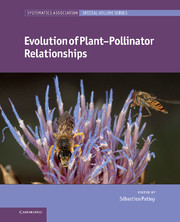Book contents
- Frontmatter
- Contents
- Contributors
- Preface
- 1 Macroevolution for plant reproductive biologists
- 2 Pollination crisis, plant sex systems, and predicting evolutionary trends in attractiveness
- 3 Evolution and ecological implications of “specialized” pollinator rewards
- 4 Fig–fig wasp mutualism: the fall of the strict cospeciation paradigm?
- 5 Fossil bees and their plant associates
- 6 Pollen evidence for the pollination biology of early flowering plants
- 7 Pollinator mediated floral divergence in the absence of pollinator shifts
- 8 Animal pollination and speciation in plants: general mechanisms and examples from the orchids
- 9 Why are floral signals complex? An outline of functional hypotheses
- 10 A survey on pollination modes in cacti and a potential key innovation
- 11 Zygomorphy, area, and the latitudinal biodiversity gradient in angiosperms
- 12 Ambophily and “super generalism” in Ceratonia siliqua (Fabaceae) pollination
- 13 Structure and dynamics of pollination networks: the past, present, and future
- 14 Pollinators as drivers of plant distribution and assemblage into communities
- 15 Effects of alien species on plant–pollinator interactions: how can native plants adapt to changing pollination regimes?
- 16 Pollen resources of non-Apis bees in southern Africa
- 17 Advances in the study of the evolution of plant–pollinator relationships
- Index
- Plate section
- References
2 - Pollination crisis, plant sex systems, and predicting evolutionary trends in attractiveness
Published online by Cambridge University Press: 05 January 2012
- Frontmatter
- Contents
- Contributors
- Preface
- 1 Macroevolution for plant reproductive biologists
- 2 Pollination crisis, plant sex systems, and predicting evolutionary trends in attractiveness
- 3 Evolution and ecological implications of “specialized” pollinator rewards
- 4 Fig–fig wasp mutualism: the fall of the strict cospeciation paradigm?
- 5 Fossil bees and their plant associates
- 6 Pollen evidence for the pollination biology of early flowering plants
- 7 Pollinator mediated floral divergence in the absence of pollinator shifts
- 8 Animal pollination and speciation in plants: general mechanisms and examples from the orchids
- 9 Why are floral signals complex? An outline of functional hypotheses
- 10 A survey on pollination modes in cacti and a potential key innovation
- 11 Zygomorphy, area, and the latitudinal biodiversity gradient in angiosperms
- 12 Ambophily and “super generalism” in Ceratonia siliqua (Fabaceae) pollination
- 13 Structure and dynamics of pollination networks: the past, present, and future
- 14 Pollinators as drivers of plant distribution and assemblage into communities
- 15 Effects of alien species on plant–pollinator interactions: how can native plants adapt to changing pollination regimes?
- 16 Pollen resources of non-Apis bees in southern Africa
- 17 Advances in the study of the evolution of plant–pollinator relationships
- Index
- Plate section
- References
Summary
Introduction
Since publication of The Forgotten Pollinators by Buchmann and Nabhan (1997), the term pollination crisis has gained widespread currency. Catchy phrases like “silent springs” and “fruitless falls” have been adopted in both the scientific literature and newspapers. Sub-optimal pollination of crops incurs an economic cost; less pollination may also lead to profound changes in the species composition of ecosystems all over the world. However, Aizen et al. (2008) have recently challenged the related idea that colonies of honeybees are generally on the decline (Jacobsen 2008). Analyzing data obtained from the FAO, they noted a downward trend in the number of bee colonies in Europe and North America, but an upward trend in non-industrialized countries that more than compensated for the decline. While this is good news, it is not the whole story. Aizen et al. (2008) also noted a trend in the crops that are being grown. Traditionally, wind-pollinated grains (rice, maize, wheat, rye) make up most of the world’s food supply. Now, insect-pollinated crops are on the rise – crops like Brazil nut, cocoa bean and oil palm. This creates a need for more honeybee colonies or other alternative pollinators, which is a challenge for the future. In this context it is useful to reflect on the likely effects of reduced pollination levels on natural ecosystems. Here I shall focus on plant sex systems and plant attractiveness in the context of reduced pollinator visitation, approaching the problem in the context of what is known about the evolutionary ecology of plants.
Expected effects of reduced pollination: dioecy and gynodioecy
The great majority of angiosperm species have perfect flowers. These flowers have both male parts that bear pollen, and female parts that receive pollen and later produce fruits and seeds. Combining the two sexes into a single flower is economic, sharing the costs of pollinator attraction and reward over the two sex functions. The proximity of the male and female organs has dual consequences, however. In plants that are self-compatible (SC), when pollinators are in short supply, selfing provides reproductive assurance, and this can be positive. Proximity may also be negative, though, when self-pollen on the stigma prevents outcrossing and reduces seed set, even in self-incompatible (SI) species (Webb and Lloyd 1986; Bertin 1993). These negative effects are known as pollen–stigma interference or pollen–pistil interference.
- Type
- Chapter
- Information
- Evolution of Plant-Pollinator Relationships , pp. 28 - 43Publisher: Cambridge University PressPrint publication year: 2011
References
- 1
- Cited by



